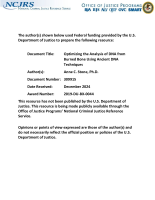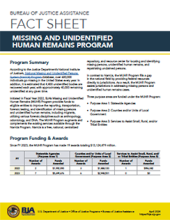Forensic anthropology
Optimizing the Analysis of DNA from Burned Bone Using Ancient DNA Techniques
Date Published
2024
Agencies
NIJ-Sponsored
A Virtual Anthropological Approach to the Study of Commingled Human Remains
Date Published
2024
Agencies
NIJ-Sponsored
Skeletal Trauma in Forensic Anthropology: Improving the Accuracy of Trauma Analysis and Expert Testimony
Date Published
January 2024
Agencies
NIJ-Sponsored
Learning from Our Casework: The Forensic Anthropology Database for Assessing Methods Accuracy
Date Published
2024
Agencies
NIJ-Sponsored
The Off-season of Dental Cementum Investigations. A Critical Appraisal of Season-of-death Prediction in Medico-legal Investigations
NCJ Number
309645
Journal
Archives of Legal Medicine
Date Published
2024
Agencies
NIJ-Sponsored
Publication Link
Estimation of Sex Assigned at Birth Using Dental Crown and Cervical Measurements in a Modern Global Sample
NCJ Number
309468
Journal
Journal of Forensic Sciences
Date Published
2024
Agencies
NIJ-Sponsored
Publication Link
Stature Estimation Equations for Modern American Indians in the American Southwest
NCJ Number
309448
Journal
Forensic Science International
Date Published
August 2024
Agencies
NIJ-Sponsored
Publication Link
Unidentified Human Remains
Date Published
January 2024
Agencies
OJJDP-Sponsored
Reassociation of Skeletal Remains Using Laser-Induced Breakdown Spectroscopy
NCJ Number
309160
Journal
Analytical Chemistry
Date Published
June 2024
Agencies
NIJ-Sponsored
Publication Link








